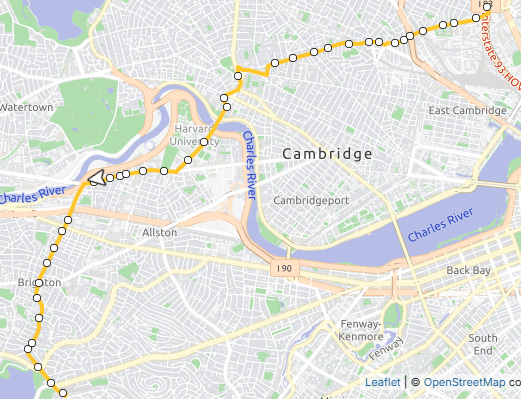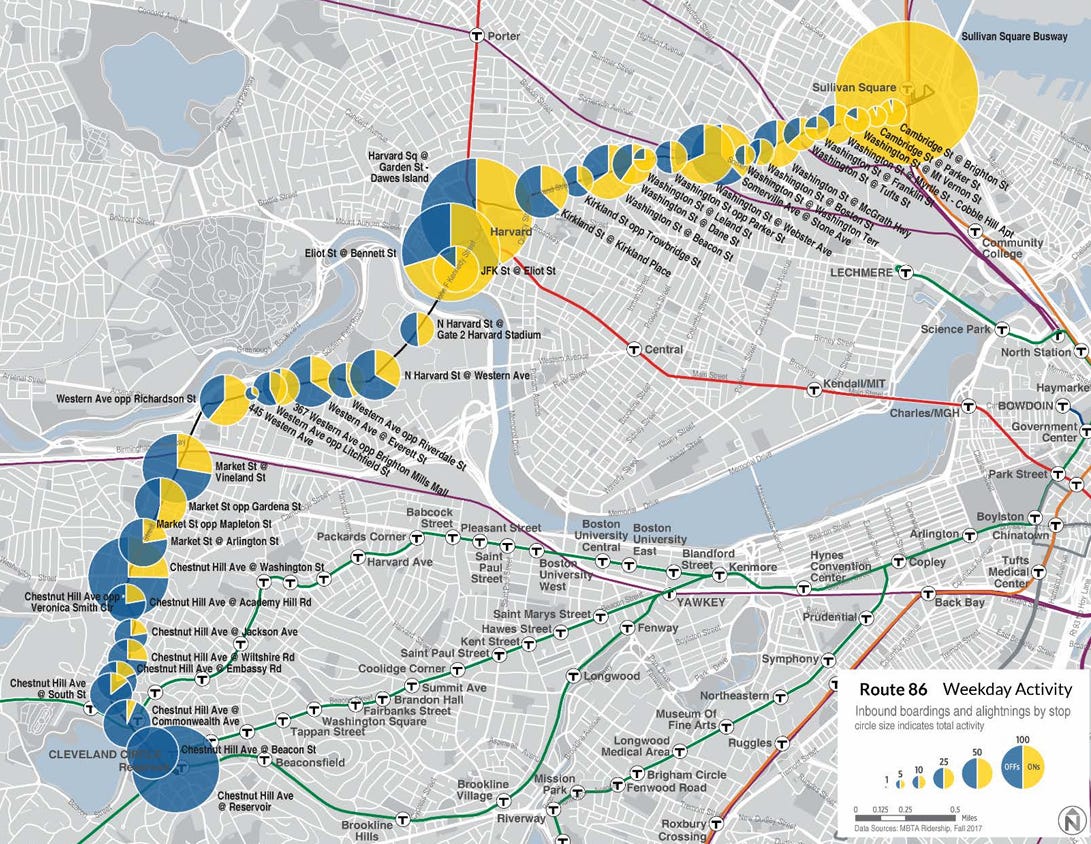The Better Bus Project is the MBTA’s most significant advancement of their public transportation services in many decades. Here at BostonTransit, we will be breaking down the changes route-by-route, with critical evaluation. Priority for articles will be given to routes announced in existing implementation phases.
A few months ago, the MBTA announced the first Phase of the Better Bus Project. Phase 1 will serve as a pilot project for the broader implementation of the new bus system, allowing the MBTA to identify issues during rollout on a small scale, before moving into larger projects.
Six bus routes will be edited during this initial change, spanning from Brighton to Everett. Today, we will look at the 86 and the T109.
Route 86 - A victim of success
The current 86 bus runs from Reservoir Station on the Green-D Line at the Brighton/Brookline border, through Brighton Center, Lower Allston, Harvard, Union Square, before finally arriving at Sullivan Station, for a roughly 7 mile route. The trip takes 30-50 minutes, depending on traffic and ridership volume. And of course, there is a reason we are starting by talking about the 86, before going into the key bus route. That is, of course, because the 86 is the 18th highest ridership route in the system, and carries more riders than 4 key bus routes. This is in spite of a schedule that is heavily peak-skewed, with poor weekend and evening service.

Ridership is consistently high across the majority of the route, due to the high-density populations it serves, particularly in Brighton Center and Cambridge/Somerville. Sullivan Square and the 4 Harvard stations make up by far the largest amount of ridership, as the direct Harvard-Sullivan trip is common, due to the two stations’ status as major multi-modal transit hubs.

The MBTA writes the following about the route:
On weekdays, Route 86 has very strong peak period ridership in both directions, when ridership per trip frequently exceeds 80 passengers (see Figure 4 and Figure 5). In spite of high levels of ridership turnover, many AM peak outbound trips exceed the MBTA’s loading standards, and others come close. Midday ridership is significantly lower, but still exceeds 40 passengers on most trips. Midday ridership levels are also likely depressed by the infrequent service that is provided (as infrequent as every 40 minutes). Evening and night ridership is higher, with 40 to 50 passengers on most trips through nearly 10:30 PM, and probably also somewhat depressed by infrequent service.
Among the issues plaguing this route are unbalanced ridership, with the Harvard-Sullivan leg driving the majority of traffic, bunching due to traffic in Somerville, poor stop spacing, and poor service levels.
It is clear that the current situation with the 86 is completely untenable. For that, the MBTA proposed a bold solution.
The solution?
The Better Bus Project proposes to extend route 109 from Sullivan station all the way to Harvard, tripling the frequency of the route and elevating it to key bus route status, now denoted by a T in front of the number.
The current route 109 runs at 17-35 minute frequencies from Linden Square to Sullivan via Everett. The ridership along this route is almost entirely hub-based, with the overwhelming majority of trips having Sullivan as an endpoint. This bus is duplicated through most of Everett by route 104, which is being re-routed away from Broadway in the upcoming bus design (more on that next week!). By removing route 104 from the equation, service on 109 would need to be increased anyways, to handle the flow of passengers from downtown Everett to Sullivan.
The new routing of T109 sees the route absorb the old second half of the 86 bus route, increasing the length of T109 to 7 miles.
If you’ve been paying attention, the issue with this routing should be immediately apparent. Some of the major issues with the 86 included unbalanced ridership distribution, length of route, and poor stop spacing. Well, the T109 doesn’t really seem to address those at first glance.
Now, it still is likely significantly better than the existing system. Using Harvard’s snarl of narrow streets, high traffic, and complicated bus tunnel as a midpoint for a route never really made much sense and was just asking for delays. Furthermore, through trips from one half of the 86 to the other were rare, with most trips starting or ending at one of the three major stations (Reservoir, Harvard, Sullivan). So having Harvard as a terminus makes much more sense.
Additionally, bus lane improvements along Broadway and Washington Street will make this route vastly superior to the 86 in terms of speed, as the 86 must navigate narrow, parking-laden streets such as Western Ave.
But really, why do we need to tack on another route to Harvard-Sullivan? Why can’t that just be operated as its own bus, with its own frequencies? How many people are really making Everett to Cambridge trips? Why make a route that is so long, when drivers hate long routes, and riders aren’t going to use the length of it, and you already have a known, major bus transfer station right at the middle for those who do want to continue onward? It seems as though the situation will become similar to that of the 86, with two seperate groups of trips (Everett-Sullivan, Harvard-Sullivan), that should just be two bus routes.
Shorter 86 Service
But what happens to the old 86? Well, the routing remains in place, but it gets cut back halfway, running between Reservoir and Harvard. Frequencies on the route get cut significantly at peak time, in order to allow for slightly improved frequencies in the evening and the morning. Not pictured below, is a 5-minute increase in weekend frequencies, from 30 minutes to 25. These are not inconsequential, but not substantial.
Truthfully, folks in Brighton are getting very little out of this change, if anything. Any gains in reliability by removing the Sullivan leg of the journey are being outweighed by lousy frequency.
Furthermore, one of the most significant issues with Route 86 is going unaddressed, that being the ridiculous stop spacing. There are several bus stops that are spaced far too close together. I will single out the most ridiculous of them, once again citing the MBTA:
290 feet separate Western Avenue opposite Litchfield Street and the stop at 445 Western Avenue, resulting in a large ridership imbalance, with about 120 passengers using the former stop and 20 passengers using the latter stop.
Nothing is done about this ridiculous stop spacing in the proposed changes. There are still far too many stops along Western Ave. as well as too many stops between Commonwealth Ave. and Washington St.
And it’s not as if the 86 is a supplemental route that the T need not care greatly about. It is the ONLY link to Cambridge (and all of the suburban routes that serve Harvard) for the densely-populated, transit dependent neighborhoods of Brighton Center and Aberdeen. Further development along Western Ave. in association with Harvard and Allston LabWorks will only increase the demand for route 86. Hopefully, the MBTA will address the service levels on this route over time.
So, there you have it, the first of the many, many bus route reviews I will be doing here over the next few years. Most probably a lot more positive than this one. Make sure to smash that like button, share this with people who might be interested, and subscribe for more! The primary content of this Substack will ALWAYS be free. I may eventually add paywalled bonus content, depending on response, but there are no plans for that right now.









Good content, I like this, make more
I couldnt find a coherent explanation of the transition from 86 to T109 anywhere until now. Thank you!